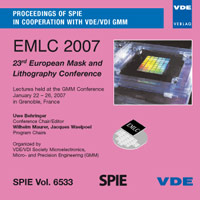Time Resolved Evolution of the Etch Bias
Konferenz: EMLC 2007 - 23rd European Mask and Lithography Conference
22.01.2007 - 26.01.2007 in Grenoble, France
Tagungsband: EMLC 2007
Seiten: 9Sprache: EnglischTyp: PDF
Persönliche VDE-Mitglieder erhalten auf diesen Artikel 10% Rabatt
Autoren:
Nesladek, Pavel; Paul, Jan (Advanced Mask Technology Center, Rähnitzer Allee 9; 01109 Dresden, G)
Inhalt:
Increasing demand for high end masks with ever-narrowing specifications for critical dimension uniformity (CDU), CD linearity, etc. is the major driver for the further process development. Decreasing the main feature size and increasing the complexity of sub-resolution assist features (SRAF) are restricted by the resolution limit of the mask manufacturing process, which is determined by the resolution limit of the mask lithography process and the widening of the clear structures in etch processes – etch bias. In order to be able to compare and develop new etch processes, a reliable and well reproducible method for etch bias estimation has to be established. Previous investigation shown, that there is a gap between etch bias estimation by mean of CD SEM and AFM methods. The measurement of the CD value in resist was identified as the major problem of the etch bias estimation for several reasons. We searched for a measurement method that minimized the disadvantages of the resist CD measurement; ideally making the resist CD measurement obsolete. Since the widening of the features can be observed at the Cr edge as well, our experiment focuses on the measurement of the upper Cr edge shift as function of time which provides the information about the etch bias as well as the time evolution of the CD and side wall angle. In our work we present a method for measurement, one can adopt as etch bias measurement and use it as a way for calibration of the easy to use etch bias measurement methods like AFM, CD SEM and optical CD measurement. The understanding of the process of structure widening gives us a confidence, that the method suggested is correct and explains well, what the limitations of the etch bias are. Last but not least the proof is given, that there is no Cr etch process with zero etch bias possible.


